TRIP REPORT: MAINE – 2019 June – Mountains & Coast

TOUR FOCUS
TRIP LEADERS
PRIVATE TOUR OPTION
This tour is available as a private trip for any size group. The tour cost will vary with the number of people and any custom requests.
TESTIMONIALS
Trip Report written by Alex Lamoreaux
Day 1 / June 2, 2019
Following a delightful week guiding fieldtrips for the Acadia Birding Festival on Mount Desert Island, Maine, I headed north to the Bangor International Airport for a noon meet-up with my adventurous birders; Janet, Leslie, Matt, Joan, and Dave.
Leslie, Joan, and Dave had arrived early to join in on the birding festival too, while Janet and Matt flew in Sunday morning and arrived more or less on time. We immediately hit the ground birding, with a Northern Mockingbird on the fencing at the airport as we cruised over to Essex Woods & Marsh. This small birding patch near downtown Bangor is a great introduction to eastern wetland birds. It was overcast but calm and pleasant, and the birds were active. We noted Red-eyed Vireo, Blue Jay, and American Crows as we walked down to the marsh.
I noticed some activity in the middle of the pond, and looking closer realized it was a North American River Otter! The otter slowly swam across the pond, occasionally ducking underwater. Following a nice trail bordering the edge of the wetland gave us close views of Alder Flycatchers, Baltimore Orioles, a pair of Green Herons, Hairy Woodpecker, Eastern Kingbirds, and Red-winged Blackbirds.

‘Myrtle’ Yellow-rumped Warbler (Photo by Alex Lamoreaux)
I took a few moments to point out the local subspecies of Common Grackle, known as ‘Bronzed Grackles” for their shiny, bronze bodies and metallic blue heads….very different from the ‘Purple Grackles’ further south along the Atlantic Coast. Further down the trail we found a female Yellow Warbler building her nest out of cattail fluff!
Other warblers included Common Yellowthroat, American Redstart, Black-and-white, ‘Myrtle’ Yellow-rumped, and Chestnut-sided. Singing Warbling Vireos were particularly abundant. We also saw a hen Mallard with her ducklings, and had quick views of a female Hooded Merganser. Two Common Muskrat gave us nice views as they carried freshly-cut cattails through the water to their burrows.
With 30 species under our belts, we headed south towards Mount Desert Island. As soon as we arrived on the island, we made our way over for lunch at Geddy’s in Bar Harbor, but not before scanning the harbor for our first Common Loon and Black Guillemots! Herring and Great Black-backed Gulls were in abundance. House Finch and Song Sparrow sang around a small park near the harbor.
After lunch we drove into Acadia National Park. This beautiful park makes up about 70% of the island. On limited time, we only had the opportunity to bird one location; Sieur de Mont Spring. A Gray Catbird welcomed us, as it crept around stealing smushed bugs off of car grills! Heading down the trail, through the beech and hemlock forest, we quickly heard the distinct ‘Who cooks for you, who cooks for you all’ calls of a Barred Owl. This was our target here, so it was great to confirm that we were close.
Further down the trail we found an adult owl roosting in a large hemlock, and quickly realized there were also 2 fluffy nestlings huddled into a large cavity in a snaggy tree along the trail. Clambering around for the best angle, we spent a few minutes watching and photographing the owls before heading back to the parking lot.
Zig-zagging our way across to the southwestern portion of the island, we headed over to my friend Tony’s house to try and see a pair of ‘Taiga’ Merlin who had built a nest in her yard! How lucky! Tony and a few other birders were already on site when we arrived, but the Merlin were not. We had nice scope views of the nest…a clutter of sticks high in a spruce. I took some time explaining how Merlin populations are surging across the country, and each year they are being recorded nesting further and further south – taking advantage or ample prey and nesting locations in urban environments.

Common Loon (Photo by Alex Lamoreaux)
Scanning the harbor from below Tony’s house we spotted a pair of Common Eider, 6 Black Guillemot, 1 immature Common Loon, and Herring Gulls. The tide was low so it was neat to see the huge tide flux here…nearly 8 feet!
Back up around the house we watched a super cooperative Hermit Thrush, and heard American Redstart and Black-throated Green Warblers singing. A pair of Eastern Kingbirds perched in beautiful afternoon lighting made us pause for a few minutes, which was perfect timing as I spotted one of the Merlin flying past! Success!
We had a 1.5 hour drive up the coast to Machias, so it was time to hit the road. Leaving Mount Desert Island, and crossing over the casuseway near Thompson Island produced a pair of Common Merganser.
Machias is a tiny coastal town, with limited amenities, but we found a nice pizza place for dinner and heard a Spotted Sandpiper calling from the parking lot! Greg Miller also joined us for dinner, and would be with us for the boat trip the next day. It was great to talk with Greg at dinner about his Big Year and thoughts on birding in America.
Our first night was spent at the cozy (and birder-friendly) Bluebird Motel.
Day 2 / June 2, 2019

Our intrepid group on route to Machias Seal Island
The highlight of this tour is the opportunity to travel out onto the Gulf of Maine and visit a puffin colony. And today was the day! Foggy, rainy, windy conditions made me nervous, but the captain said we should meet at the Cutler Harbor at 10:30am and discuss options. That gave us plenty of time for a filling breakfast in Machias, and then make our way down to Cutler. On the way we passed a fish hatchery which had gathered 300 Double-crested Cormorants and a few Osprey.
We arrived in Cutler to find the harbor completely socked in with fog. Waves were lapping up onto the rocky shoreline, and the captain seemed concerned about our trip out to the puffin colony on Machias Seal Island.
Captain Andy explained the weather conditions, and said that he would be willing to take us out to motor slowly around the island, but based on the conditions it wouldn’t be possible to actually make a landing and get into blinds to see the alcids up close. This warning managed to scare off most of the other folks signed up to go out on the trip, so our intrepid group had the boat mostly to ourselves!
We loaded the old lobster boat, and headed out of the foggy harbor just before 11am. The Gulf of Maine is a 36,000 square mile region that provided the former haunts to the extinct Sea Mink and Great Auk. Today the gulf is alive and well, with a prosperous fishing community and where rare animals like the Northern Right Whale and the charismatic Atlantic Puffin still call the deep underwater canyons and rocky islands their home. And puffins are what this whole boat trip is about!

Machias Seal Island shrouded in dense fog (Photo by Alex Lamoreaux)
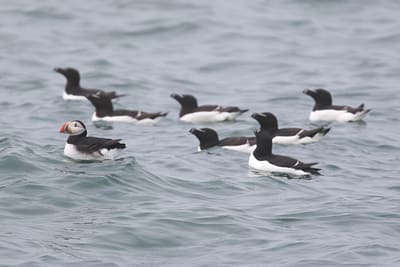
Atlantic Puffin with Razorbills (Photo by Alex Lamoreaux)
Making our way out onto the sea, the waves were about 3 to 4 feet and it was quite windy, but we quickly started spotting pairs and small groups of Razorbill. It wasn’t long before a few Atlantic Puffin flew by, and we spotted two immature Northern Gannets. An Arctic Tern and a Common Murre also made brief appearances.
As we approached Machias Seal Island, numbers of birds grew exponentially. Slowly the island and its lighthouse appeared out of the fog, perfectly setting the stage for this mystical journey out to a very magical place.
The island was absolutely buzzing with activity; 500 Common Eider floated along the rocky shoreline, at least 1000 Razorbills floated alongside the boat and zipped past us in flight, over 100 Arctic Terns and a handful of Common Terns flew around us. Herring and Great Black-backed Gulls were scouring the area for an easy meal. And, of course, the stars of the show (or maybe the clowns of the circus) were the 1600 Atlantic Puffin covering the island and floating all around us!
Despite the fog, and not being able to get onto the island, we had incredible views of these beautiful alcids up close! Being able to visit such an active puffin colony is truly an experience that every nature-lover has got to do at least once in their lives. A trip to Maine wouldn’t be complete without seeing the clownish looks and quirky personality of the Atlantic Puffin, and we were so happy to make this trip happen.
Other highlights around the island were seeing a lonely adult Northern Gannet nest-building among the puffins and Razorbill, 1 Osprey, and spotting the tiny shapes of Savannah Sparrows in the tall grass on the island along with wayward Gray Catbird and Brown Thrasher sneaking around the lighthouse and buildings on the island.
Harbor Seals loafed on the rocky shoreline of the island, but Gray Seals were surprisingly absent. We spent 1.5 hours slowly circling the island, getting great views and awesome photographs of the seabirds, but then it was time to head back in. (One side note about this experience is that both the United States and Canada claim ownership over Machias Seal Island, so we logged our sightings on eBird for both countries!)

Atlantic Puffin fly-by! (Photo by Alex Lamoreaux)
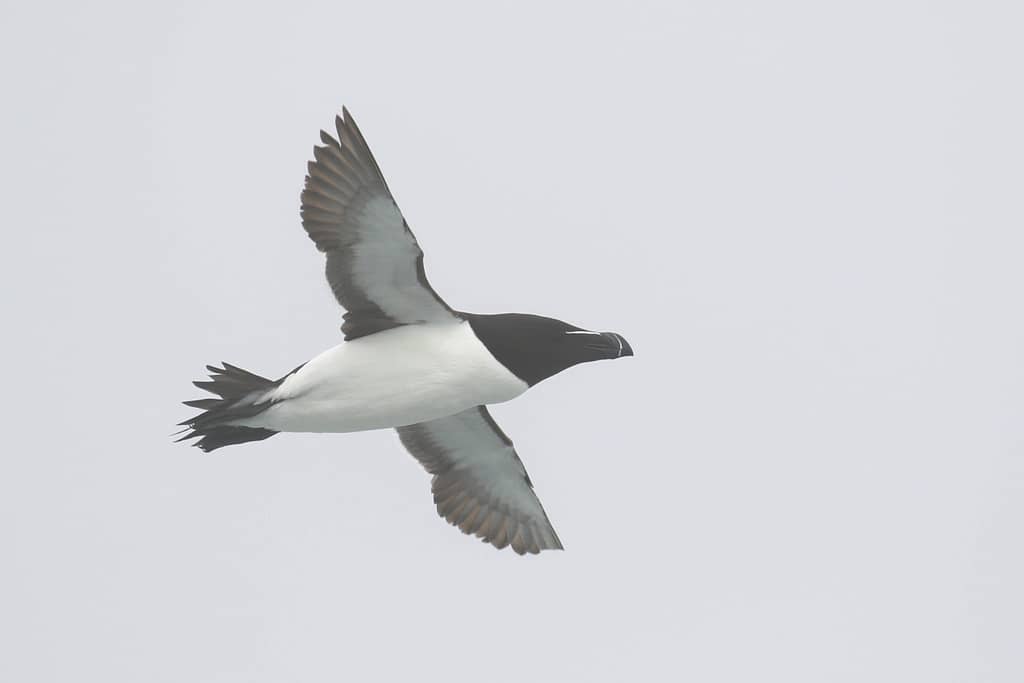
Razorbill fly-by! (Photo by Alex Lamoreaux)
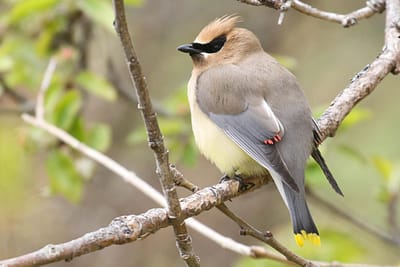
Cedar Waxwing in Cutler (Photo by Alex Lamoreaux)
In Culter Harbor we were welcomed back to dry land by a beautiful flock of Cedar Waxwings, gathered at eye-level as they fed on flower buds in the parking lot. We spent a few minutes getting photographs of the waxwings, and regaining our footing on stable ground.
Lunch was back in Machias where we enjoyed some delicious (locally-grown) blueberry pie!
The blueberry barrens of Maine are an iconic scene, and we had many nice vistas of the barrens and forest as we made our way southwest towards the state capital, Augusta.
We stayed at the Quality Inn in Augusta for the night.
Day 3 / June 4, 2019
After a quick breakfast at the hotel we set off for the nearby Harrison Avenue Nature Trail. We birded there along the Cobbosseecontee Stream for 1.5 hours and noted 36 species, including many first-of-trip species like a flyover immature Broad-winged Hawk, Eastern Wood-Pewee, Northern Cardinal, and Tufted Titmouse. Our only Cliff Swallow of the tour made a quick flyover appearance. The highlight here was seeing a few warblers, including nice views of a female Blackpoll Warbler. The titmice and cardinal are classic examples of southern species that are slowly expanding their ranges further and further north.
Next we made our way further south, towards Portland. We would spend the remainder of the day birding along the coast in the Portland area, with the primary goal of trying to track down at least one of the multiple Little Egrets that have colonized this small portion of the coast over the last few years.
Little Egret are the European equivalent to our Snowy Egret, and are very similar in appearance – close study of the head plumes is required. Snowys have a short, fluffy crest while Little Egrets have two long, whip-like plumes. Snowy Egrets are common in the area, and careful scrutiny of any white egret is needed.
Our first stop was to Tidewater Farm; an old farmstead that has been donated as a conservation easement. This small property is a nice birding destination, but it is sad to see the old farm buildings slowly decaying. We didn’t turn up a Little Egret here but did have nice views of Snowy Egrets, a few Glossy Ibis, another Broad-winged Hawk, multiple Osprey, a pair of Red-tailed Hawks, and we heard a Chestnut-sided Warbler singing while a Yellow Wabler sang which was a nice opportunity to compare their similar songs.

Little Egret (Photo by Alex Lamoreaux)
Next we moved a mile around the shores of Presumpscot Bay to the Gilsland Farm Audubon Center to continue our search for a Little Egret, and see what other birds we could turn up. In line with our theme of southern intruders we saw Red-bellied Woodpecker, Tufted Titmouse, and White-breasted Nuthatch at the center’s feeders – all at the northern limits of their ranges here. Other highlights included Baltimore Oriole, Willow Flycatcher, male Wild Turkeys displaying to a shy female, an adult male Cooper’s Hawk mobbing an immature Red-tailed Hawk, Chipping Sparrows, and a quick flyby Belted Kingfisher.
Down along the shoreline we spotted Glossy Ibis and Double-crested Cormorants. We encountered two birders there, and quickly learned that they had seen what they thought was a Little Egret and were searching for where it might have flown off to. Woah! We were hot on the heals of a sighting.
Our group kicked into chase mode and we set off across the fields, to scan the bay from multiple vantage points. We weren’t turning up anything, not even a Snowy Egret, until at the very last overlook I spotted a distant white egret hiding at the edge of a dense patch of phragmites. Upon closer inspection it was clear this was a Little Egret! It lifted from the marsh and moved 100 feet close to us; its beautiful plumes whipping around in the wind! The whole group was so excited and high-fives were given all around!
Again the egret lifted and moved another 100 feet closer to us! We couldn’t believe our luck, and enjoyed great views of the rare egret as it hunted through the marsh. Once again the egret lifted off and appeared to be heading out way but then detoured and headed inland. We snapped off photos and again rejoiced in our good luck, making sure to thoroughly thank the two birders we met for the tip-off!
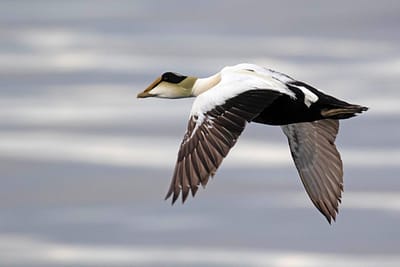
Common Eider (Photo by Alex Lamoreaux)
Making our way over to the causeway for Mackworth Island, we saw some Common Eider up close and had better views of Snowy Egrets. A busy morning of birding left us very ready for lunch, so we headed into downtown Portland and enjoyed unique sandwiches at a natural foods store. Herring and Great Black-backed Gulls soared overhead while we ate lunch.
After lunch we made our way further down the coast, making a quick stop at Pond Cove to search for an overshoot Yellow-crowned Night-Heron. We didn’t have luck with the night-heron, but did have our first good looks at American Black Duck and a hybrid Mallard x American Black Duck. These range-restricted and declining waterfowl are still fairly common in the saltmarshes of southern Maine, but it was neat to see the hybrid and discuss how a combination of threats are affecting this duck. Hybridization with Mallards and rising sea levels are a major double-whammy issue for the future of American Black Ducks.
Crescent Beach State Park was next on our route, and we quickly spotted a raft of Black Scoters among Common Eiders. We also had stellar views of a female Piping Plover along the surf, which was soon joined by a small flock of Semipalmated Sandpipers! The plovers are threatened throughout their range, and are considered endangered in Maine.

Piping Plover (Photo by Alex Lamoreaux)
We made a quick stop for ice cream (which included ‘Purple Piping Plover’…black raspberry, white chocolate chunks, and chocolate chips), and then made our way to the saltmarshes at Scarborough Marsh. Chimney Swifts made a nice appearance overhead while we ate our ice cream! The Nonesuch River winds its way through the saltmarsh, creating a beautiful and expansive habitat for a variety of neat birds. Our targets here were Saltmarsh Sparrow, ‘Eastern’ Willet, and Least Tern.
Quickly upon exiting the car and walking out the path through the marsh, we could hear the screaming calls of willets and it wasn’t long before we had great views of a few of them and were able to discuss how differenct in appearance, calls, habitat, and habits they are from the ‘Western’ Willet. Eventually these birds will be split…

Great Black-backed Gull (Photo by Alex Lamoreaux)
Sparrow activity was very quiet compared to my previous visits here, and we worked hard to get views of Saltmarsh Sparrow – but we did see a few well. It was particularly interesting to watch a perched-up Saltmarsh Sparrow get body-slammed by a female Red-winged Blackbird! These small, cryptic sparrows have never been established as endangered species, but they certainly deserve it – their global population (which is entirely restricted to the saltmarshes of the Atlantic Coast of the USA) is declining by 9% per year.
A few Least Terns circled above the marsh, and Great Black-backed Gulls gave us nice views – the smallest tern in the country, and the largest gull in the world.
Feeling quite happy with our time in the marsh, we made our way back to the car – but I couldn’t help but keep a close eye on all the white egrets, and just before reaching the car I spotted another Little Egret! Woah! Two Little Egrets in one day! We watched it foraging alongside a Snowy Egret for a truly awesome comparison. Even better was getting to share this bird with another birder, who had made a dedicated trip there for her lifer Little Egret, and had been having a hard time tracking one down.
Our final birding destination of the day was to the small harbor at nearby Pine Point Beach. Common Terns were flying all around the harbor, joined by a few more Least Terns. We also had distant views of some immature Bonaparte’s Gulls, Black-bellied Plovers, and a large flock of Semipalmated Sandpipers. A single American Oystercatcher made a nice flyby, and we watched a bunch of gulls and terns gang up on an adult Bald Eagle.
Just around the corner is the Clambake Restaurant where we enjoyed a classic Maine seafood dinner, with many guests having their first lobster dinner!
We spent the night at the Ramada in Portland.
Day 4 / June 5, 2019
We kicked off day 4 with breakfast at Dunkin’ Donuts…a destination that must be visited in New England! It was foggy and drizzling, but we set off for nearby Capisic Pond to search for some migrant songbirds. Despite the weather, we were treated to nice views of a male Orchard Oriole, a pair of Wood Ducks, 2 Blackpoll Warblers, and a last-minute Black-crowned Night-Heron!
Our next stop was the blueberry barrens, sandhills, and grasslands at Kennebunk Plains. This habitat type is rare and declining in Maine, and hosts a few rare plants – like Northern Blazing Star – that are found nowhere else on Earth. The savannah-like habitat is a great location for Grasshopper, Savannah, and Vesper Sparrows in addition to Eastern Towhee and Brown Thrasher – all of which we were unlikely to encounter anywhere else during the tour. We had a smashing success by seeing all of the above!
Upland Sandpiper, however, wasn’t being as nice to us. We heard the distinctive calls of an Upland, but could never track it down. Prairie Warblers were singing from the scrubby pines nearby, and we saw multiple American Kestrel hover-hunting the area. At this location we also had our first encounter with dog ticks, and multiple clients had to pick a few off their pants when we got back to the car. Annoying, but a common problem when birding in New England.
We cruised down Maguire Rd for another shot at Upland Sandpiper, but didn’t have any luck. In the pasture of an alpaca farm we spotted a male Bobolink, but it disappeared quickly.
Our time along the southern Maine coast had now come to an end; birding the sea, saltmarsh, lowland forests and other habitats had been wildly successful so far, but any birder visiting Maine would be filled with eager anticipation to begin our journey north through the forests towards the Canadian border. So from Kennebunk Plains, we started our journey north towards inland Maine and New Hampshire.
Our next birding locale was a good ol’ northwoods bog. We had a winding hour and 30 minutes drive up to Fryeburg, Maine where we had a quick lunch at the Smokehouse. After lunch we drove to the nearby Brownfield Bog, arriving by 3:20pm. One Yellow-throated Vireo destroying a Chalk-fronted Corporal (dragonfly) provided the only sighting of this colorful vireo for the trip, and we also had really nice views of Yellow-bellied Flycatchers, ‘Eastern’ White-breasted Nuthatches, and a pair of Blue-gray Gnatcatchers. The unique and beautiful song of a Veery captivated our attention, and we eventually tracked it down and had nice views of this pale-rufous thrush perched at eye-level.
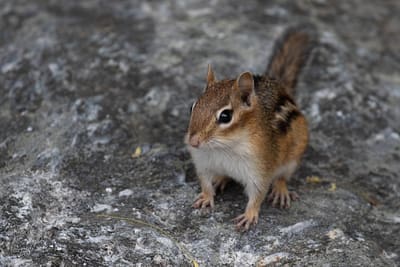
Eastern Chipmunk (Photo by Alex Lamoreaux)
The remainder of the afternoon was spent traveling even further north and crossing the border into New Hampshire, cruising our way through the scenic and richly-forested mountainsides of New Hampshire’s White Mountains. American Robins, American Crows, and Common Ravens were common along the road. We made a quick stop at Pinkham Notch where we searched the bog for a Moose (no luck) but did spend some time with a friendly Eastern Chipmunk.
The Glen House was our lodging for the night, at the base of Mount Washington. We ate dinner, staring up at the fog-covered mountain that would be our birding destination first thing the next day.
Day 5 / June 6, 2019
Mount Washington is the highest peak in the Northeast, at 6,288 feet, and boasts some of the worst weather and strongest winds ever recorded. It’s a beautiful place, and we savored the drive up the mountain in the morning. However, our minds were focused on hunting down our primary target here – the very rare Bicknell’s Thrush.

Bicknell’s Thrush (Photo by Alex Lamoreaux)
These thrushes are one of America’s most range-restricted and localized birds, and they are the only breeding bird that is endemic to New England and southeastern Canada. They have only recently been considered a distinct species from Gray-cheeked Thrush, and current research actually points towards them being more genetically similar to Veery. There are only a few, scattered high-altitude locations in the northeast that offer the specialized habitat the thrushes require.
A male ‘Taiga’ Merlin was watching over the entrance gate to our amusement, and then we set off up the mountainside, and quickly climbed in elevation. You could see how the habitat changes from beech, birch, and maple deciduous forest, to spruce and hemlock coniferous forest, then stunted spruces, and finally the rocky and barren alpine tundra. Climbing up through different habitat zones, you can even hear how the changes in the warbler communities are perfectly in sync with the habitat zones.
Just before 9am we made it into the subalpine zone, which is where the Bicknell’s Thrushes prefer to live. The mountain was completely fogged in and the wind was whipping, but despite the feeling there were not any birds here, we were determined to find our bird. The benefit of the weather being so terrible was that we were the only people on the mountain, and we could wander our way down the road carefree. White-throated Sparrows were singing from the stunted spruces, and broke the complete silence atop the mountain.

Bicknell’s Thrush (Photo by Alex Lamoreaux)
A little further down the road, I glanced to my right and the pale-gray shape of a chunky bird caught my attention. Bringing my binos up to the bird filled by views with a Bicknell’s Thrush! I yelled to everyone (as quietly as I could) to gather behind me and get on this bird!
We all had great views of the thrush as it stared down at us, and then it retreated back into the forest. Wow! To make it even better, we soon found another Bicknell’s slowly foraging along the edge of the road, hopping between rocks and grabbing small worms.
We also spotted a few Blackpoll Warbler, ‘Myrtle’ Yellow-rumped Warbler, a Yellow-bellied Flycatcher, and more White-throated Sparrows. All smiles, we headed back down the mountain feeling proud of our success at the high elevations of Mount Washington! A very unique place and a very unique bird!

Happy birders after finding the Bicknell’s Thrush! (Photo by Alex Lamoreaux)
At the base of the mountain, we took a quick bathroom and coffee break at the Glen View Cafe which was highlighted by watching two female Ruby-throated Hummingbirds feeding from the flowering shrubs.
From there we drove off towards Lancaster, New Hampshire. During the 45 minute drive we didn’t see too many birds, but did make a quick u-turn to see another female ‘Taiga’ Merlin perched on a snag. While we watched, she darted off her perch and snagged a dragonfly out of the air!

‘Taiga’ Merlin (Photo by Alex Lamoreaux)
We had a nice lunch in Lancaster, sitting outside on a patio overlooking the rushing Israel River. Chimney Swifts and Turkey Vultures circled overhead.
After lunch we quickly crossed the border into Vermont. Our New Hampshire list sat at 43 for the day!
This area of northern Vermont is affectionately known to locals as the ‘Northern Kingdom’. I like that title, and the forested mountains and ridges certainly frame the area like massive castle walls. This is a remote area with fantastic habitat and equally fantastic birding possibilities.

Ruffed Grouse (Photo by Alex Lamoreaux)
Winding our way deeper into the forests, I glanced over to spot a rufous-type Ruffed Grouse sunbathing at the edge of the road! I really couldn’t believe our good luck with this sighting, since I only really expect to hear one or two drumming on this tour, so to see one so well was really special. I pulled over and we all jumped out for photos and views of this stately gamebird.
Another few minutes down the road and we had arrived at one of my favorite birding destinations in New England – the infamous Moose Bog. Our primary goal for the afternoon was to track down a Spruce Grouse along the trail bordering the bog. This species is a nemesis for many birders, and even where this bird is common, it can be very easy to miss. They live in dense, old, moist spruce forests and the habitat around Moose Bog is perfect for them.
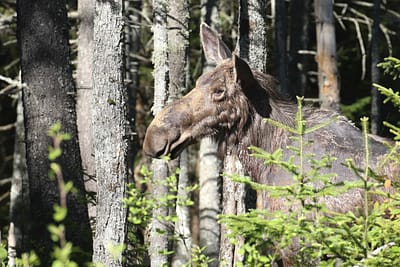
Moose (Photo by Alex Lamoreaux)
So, we set off down the trail. I walked slow and scanned back into the forest as diligently as I could. This was our best bet for finding a grouse, but that didn’t mean it was going to be easy. We made it all the way down to a short boardwalk that sticks out into a large beaver pond, and so far hadn’t found any sign of the grouse. Even their usual dust-bathing spots seemed like they hadn’t been used in awhile.
As we neared the end of the boardwalk, I scanned the edge of the pond and spotted a huge female Moose on the far side! Wow! A Moose at Moose Bog; perfect! We watched from a nice distance as the Moose went about her business, searching for lush aquatic vegetation at the edge of the pond all the while being mobbed by a very angry Canada Goose.
The edge of the pond had some really nice pitcher-plants and other cool vegetation growing, which we enjoyed briefly, but then had to continue our search for the elusive Spruce Grouse. One Canada Jay (formerly Gray Jay) was heard calling briefly. Red-breasted Nuthatch and Golden-crowned Kinglet were anything but shy, and often within feet of our faces. Other highlights included ‘Slate-colored’ Dark-eyed Junco, Ovenbird, and Northern Waterthrush. No luck with Black-backed Woodpecker, despite a sign declaring that they were nesting in the area.
Arriving back in the stretch of habitat that I consider to be prime for the grouse, I decided to split off from the group and bushwhack out through the forest and see if I could turn anything up. I think the group thought I left them alone in the woods, but not to worry – within 15 minutes I managed to flush up a female Spruce Grouse who promptly landed in a spruce above my head! I quietly yelled for the crew to climb down the hill and join me. To my amazement, the grouse stayed put, and we all had great views of this northwoods denizen! Another success at a major target bird of this tour!

Female Spruce Grouse (Photo by Alex Lamoreaux)
Checking one more spot back near the parking lot, we heard the distinctive ‘Quick, Three Beers!’ call of an Olive-sided Flycatcher, and also watched an adult Broad-winged Hawk diving on an adult Red-tailed Hawk! This beautiful little spot can be hard to leave, despite the persistent black flies, but with Spruce Grouse and Moose ‘in the bag’ it was time to head on down the road.
The visitor center to Silvio O. Conte National Wildlife Refuge was a nice bathroom stop with Eastern Phoebe, Ovenbird, Chipping Sparrow, Black-and-white Warbler, and Magnolia Warbler all seen or heard there. We ended up totaling 36 species for our brief jaunt into Vermont!
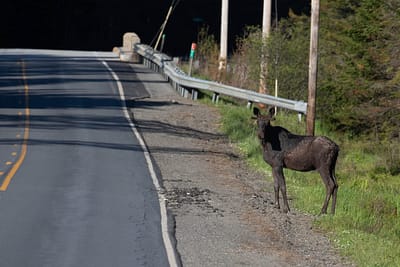
Moose along the road! (Photo by Alex Lamoreaux)
We crossed back into New Hampshire and then quickly into Maine while bombing our way east through the northern forests along highway 16, affectionately known to locals as ‘Moose Alley’. The highway lived up to its name, and we had great views of 3 Moose along the road; one female and two young males! The moose were excellent to see, but it was readily apparent on each animal that they were badly affected by ticks and had rubbed off a lot of the fur around their heads and necks. This is a direct testament to how climate change, overabundance of White-tailed Deer, and poor forest management is having a very negative impact on these iconic northern beasts.
Another Ruffed Grouse was briefly seen along the road, in addition to a pair of Ring-necked Ducks!
Arriving in the outdoorsy town of Rangeley, we immediately went to the town cove where we were welcomed by an incredibly cooperative adult Common Loon swimming and diving just offshore! It wouldn’t be a birding tour of Maine without at least one good view of these huge diving birds.
We had a nice dinner in Rangeley and spent the night at the Spillover Motel in Stratton. On the way to our hotel, in the fading light, we saw two more young female Moose which was a beautiful end to a great day birding the northwoods of Vermont, New Hampshire, and Maine! As we unloaded the car at our hotel, you could hear the winnowing sounds of a displaying Wilson’s Snipe nearby! Three states in one day, with some excellent birding and a whopping 6 Moose!
Day 6 / June 7, 2019

Friendly Canada Jay stealing a snack off one of our participant’s hats! (Photo by Alex Lamoreaux)
Our final day of this grand tour was dedicated to searching for the elusive Boreal Chickadee and enjoying a final few hours in the boreal forest of northern Maine. Boy Scout Road near the Kennebago River was our destination for the morning, and we spent a leisurely 3 hours wandering down the forest road and enjoying the birds.
Among 34 species, our highlights were 2 Yellow-bellied Sapsuckers, Hairy Woodpeckers, singing Alder and Yellow-bellied Flycatchers, a pair of Swamp Sparrows, and 10 species of warblers including our best views of Nashville Warbler.
We had a very interesting observation of a female Northern Parula battling with a female Blackburnian Warbler. The two colorful birds were so concerned with fighting each other that they didn’t even notice (or care) that we were mere feet away! A flock of 10 White-winged Crossbill flew over, but too quickly for anyone except me to get on them…
We made up for that a few minutes later by having 2 Canada Jays fly in to investigate us! The Canada Jays were literally eating from our hands! We offered them a few bits of granola, and remarked on their intelligent and inquisitive personalities.
With time running out, we were forced to leave, and you probably realize by now that yes, we dipped on Boreal Chickadee. Unfortunate, but not completely unexpected. Everyone’s spirits were still high, and we did have a really nice morning.

Canada Jay close-up (Photo by Alex Lamoreaux)
Sitting on the porch of a cafe in Rangeley made for a pleasant lunch, and many of us bought souvenir Maine-made maple syrup.
Our time in the north had come to an end, and we began our drive back down towards the coast. Our next stop was to a beautiful lake near Augusta. The marshy edge around Messalonskee Lake contains Maine’s only breeding colony of Black Terns, and they came through big-time, with a foraging flock of 8 giving us nice views as they hunted dragonflies above the marsh.
I spotted a flock of 5 adult Sandhill Cranes landing in the dense cattails, which everyone managed to get on even though they were hiding pretty well in the marsh. A very nice assortment of eastern wetland birds were also spotted; Great Blue Heron, a pair of Osprey, Warbling Vireos, Eastern Kingbirds, Baltimore Oriole, Red-winged Blackbirds. Barn, Tree, and Bank Swallow flew around overhead!

Male Purple Martin (Photo by Alex Lamoreaux)
Right down the road we made a quick stop at one of very, very few Purple Martin colonies in Maine. A noisy flock of at least 7 males and females flew low around our heads, and made for great photo opportunities!
Our final birding destination for the tour was to spend the evening at my friend’s beautiful organic dairy farm near Augusta, known as The Milkhouse Farmstore. We arrived just before 4pm and were quickly greeted by Andy Smith, my longtime friend and a very knowledgeable conservationist and farmer.
We toured the property and learned about how an organic dairy works, and how Andy and his wife Kaitlyn have implemented environmentally friendly ways to both raise dairy cows while also providing valuable habitat for grassland and forest birds. The birding highlight here was that 4 male Bobolinks were actively singing and defending territories, although a massive female Common Snapping Turtle did her best to steal the limelight.
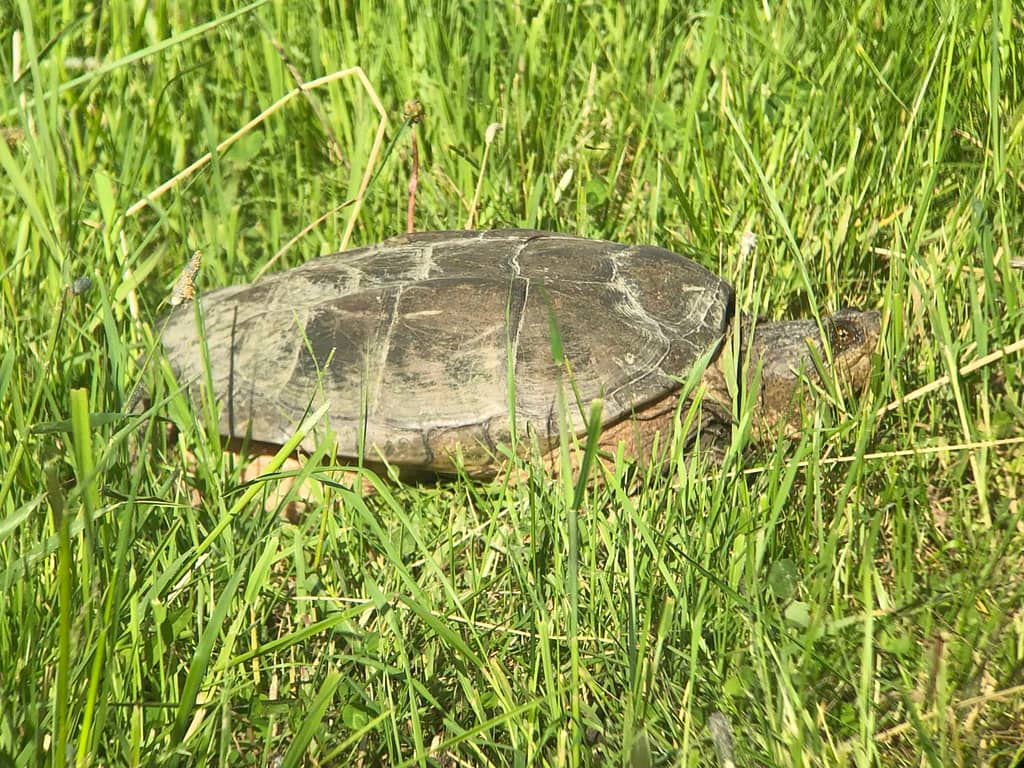
Female Common Snapping Turtle (Photo by Alex Lamoreaux)
We enjoyed a nice burger cook-out behind the farmhouse, and joked and laughed about our last week birding throughout Maine, Vermont, and New Hampshire. After a fun time on the farm, we drove northeast and spent our last night at the Bangor airport hotel.
Day 7 / June 8, 2019
Everyone had different flights out of Bangor on June 8th (with mine being the earliest) so we didn’t squeeze in any more birding. However, it was a really fantastic week birding Maine and beyond, and we totaled a very nice 145 species of birds. Other sightings included 13 mammals, 7 butterflies, 2 dragonflies, and 8 reptiles and amphibians! Please see our complete checklist for details!



